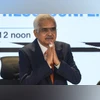Reserve Bank of India (RBI) Governor Shaktikanta Das cautioned on Friday that cutting the policy rate at this juncture could be “very premature” and “risky" in light of an uptick in the latest headline inflation reading, something that could persist until the next print, as well.
“… (A) rate cut at this stage will be very premature and can be very, very risky when your inflation is 5.5 per cent and the next print is also expected to be high, you can't be cutting your rate, more so if your growth is also doing well,” said Das at Bloomberg’s India Credit Forum.
He signalled that the RBI would only consider rate cuts once inflation is durably aligned with the 4 per cent target. “I would not like to speculate on a rate cut in advance. We will need to wait for incoming data,” he emphasised.
The RBI’s policy actions will remain forward-looking, depending on the inflation outlook. “We have to see what is the outlook on inflation for the next six months or one year… (and) based on that we would take action,” Das said.
Earlier this week, RBI Deputy Governor Michael Debabrata Patra indicated that retail inflation may durably align with the 4 per cent target by FY26. Last week, the reconstituted Monetary Policy Committee (MPC) left the repo rate unchanged for the 10th straight meeting, shifting its stance to “neutral”, fuelling speculation of a potential rate cut in December.
However, driven by a spike in food prices and a fading base effect, September’s retail inflation read a nine-month high of 5.49 per cent, tempering market expectations.
More From This Section
On whether the RBI is running the risk of falling behind the curve on rate cuts, Das firmly dismissed the notion, asserting market expectations and RBI policy are well aligned. “Certainly, we are not behind the curve,” he said. Referring to rate cuts by other central banks, Das noted: “We don’t want to join any party… And if we decide to join the party, we would like to join it on a durable basis.”
While the RBI keeps an eye on the actions of systemic central banks like the Federal Reserve, the central bank governor emphasised that domestic inflation, growth, and macroeconomic conditions primarily drive the RBI’s decisions.
Das also stressed that the central bank doesn’t act as a “policeman” but maintains a close watch on the credit market. His remarks followed the banking regulator directive for Navi Finserv and three other non-banking financial companies to cease from sanctioning and disbursing loans effective from the close of business of October 21 on material supervisory concerns, including usurious pricing. "No, we are not policemen. We are watching... When it becomes necessary, we take action,” he said.
About foreign exchange reserves, Das reiterated that the RBI has no specific target. India’s forex reserves recently crossed $700 billion, making it the fourth country to do so, after China, Japan, and Switzerland. Das attributed this strategy to the lessons of the 2013 taper tantrum, saying, “I have seen the kind of volatility the markets witnessed and the kind challenges which the RBI had to deal with. We cannot have a repeat of that situation.”
Declining for the second straight week, however, India's forex reserves dropped $10.74 billion to $690.43 billion for the week ended October 11 in one of the largest decreases in the kitty in recent times.
Contrary to speculation, Das clarified that the RBI is not managing the exchange rate. “We are not managing the exchange rate. Rupee is depreciating overall vis-a-vis the dollar, and we buy dollars whenever there is an opportunity. And when there is a dollar shortage in the market, we supply dollars to the market. He noted that since January 2022, the rupee depreciated about 11.5 per cent versus the dollar, and this is in response to “the overall movement of the dollar and the overall movement of the international market.”
Das offered no clear indication about whether he would take up a third term as RBI governor, if asked by the government. His term is set to end on December 10. “At the moment, it’s not on my mind,” Das said, adding that his immediate focus is on wrapping up ongoing initiatives.
“Several discussion papers were given out in the public domain, the comments have come. I have asked my colleagues in the RBI to try and examine those comments and our effort will be to try and issue regulatory guidelines on them,” he said. “Next MPC meeting will also come up. So, already, my table is full.”
He reflected on his six-year tenure, describing it as “challenging” but noting the RBI’s success in maintaining macroeconomic resilience and financial stability. “The RBI’s biggest achievement over the past six years has been preserving the stability of the financial system,” he concluded.

)
